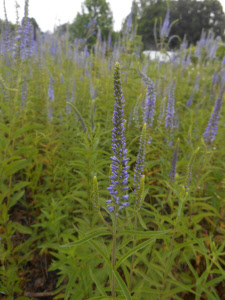Description
Erect crowd of bluish-purple star-shaped flowers cover terminal spikes all summer growing high above basil foliage. If deadheaded blooms all summer.
Erect crowd of bluish-purple star-shaped flowers cover terminal spikes all summer growing high above basil foliage. If deadheaded blooms all summer.
Erect crowd of bluish-purple star-shaped flowers cover terminal spikes all summer growing high above basil foliage. If deadheaded blooms all summer.
Brilliant orange with purple spots, turks-cap lily with dramatic, swept-back petals blooming late summer to early fall. Slow to mature but when it does it bears up to 40 flowers on one plant.
Size: 10’ x 12”
Care: Sun in moist to moist-well-drained, acidic soil
Native: from VT to Fl & west to Mississippi River, Wisconsin native
Lilium was named for the Greek word for smooth, polished referring to its leaves. This collected before 1665. In his 1665 book, Flora, seu de Florum Cultura John Rea, nurseryman and author, called it the “Virginia Martagon.” Sold in America’s 1st plant catalog, Bartram’s Broadside, 1783. L.H. Bailey (1913): “The most magnificent and showy of native North American species, well worthy of extensive cultivation.”
OUT OF STOCK
Green flowers in summer then, “conspicuous in winter when covered with its grayish white fruits which stay on the branches until spring.” Bailey “The leaves turn a fine brown-purple in the fall, but the berries are the thing – pewter in color, with a texture like those Fourth of July sparklers of childhood memory, they have a delicious fragrance.” Allen Lacy.
Size: 9’ x 10’
Care: sun in any soil
Native: Canada to Southeastern U.S. No pruning needed but can be pruned at any time of year, if desired.
Wildlife Value: Berries relished by chickadees, red-bellied woodpeckers, swallows, Titmouse, catbirds, bluebirds, Northern flicker & yellow-rumped warblers. Bayberry thickets also provide nesting sites for songbirds, offering excellent protection from predators.
Probably 1st collected for gardens by John Bartram (1699-1776). Offered for sale in Bartram Garden’s 1783 Broadside, America’s 1st plant catalog. In 1800’s considered “very ornamental in the shrubbery.” Fragrant leaves used for potpourri, abundant berries used to make candles. Good road-side plant, salt tolerant. Berries used to make candles. Boil berries (drupes) to melt wax coating. Collect wax from surface of water. In American Medicinal Plants Charles F. Millspaugh noted that “Candles made from this wax, though quite brittle, are less greasy in warm weather, of fine appearance, slightly aromatic, and smokeless after snuffing, rendering them much more pleasant to use than those made of either wax (paraffin) or tallow (animal fat).” 1892.
OUT OF STOCK
Sprays of large, single warming yellow daisies, blushed with apricot top a bushy mound of light green leaves, blooms late-summer to late-fall
Size: 1-2’ x 2-3’ and spreading
Care: Full sun to part shade, tolerates normal, sandy or clay soil
Wildlife Value: Attracts bees, butterflies and birds. Deer resistant.
One of the rubellum hybrids, Hybridized in the 1930’s
Purple, upfacing bells for months in mid to late summer
Size: 4-6” x 20”
Care: full sun-part shade in moist well-drained soil
Native: Northern Yugoslavia
Awards: England’s Royal Horticultural Society Award of Merit. Top rated Chicago Botanic Garden & Elisabeth Carey Miller Botanical Garden Great Plant Pick.
Campanula is Latin meaning “little bell.” 1st described in Systema Vegetabilium 5: 93 in 1819 by one of its discoverers, Franz Edler von Portenschlag-Ledermayer (1772-1822).

